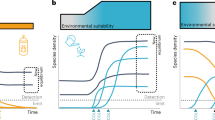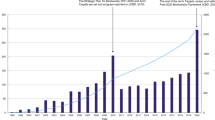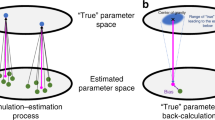Abstract
The Living Planet Index (LPI) is a standardized indicator for tracking population trends through time. Due to its ability to aggregate many time series in a single metric, the LPI has been proposed as an indicator for the Convention on Biological Diversity’s post-2020 Global Biodiversity Strategy. However, here we show that random population fluctuations introduce biases when calculating the LPI. By combining simulated and empirical data, we show how random fluctuations lead to a declining LPI even when overall population trends are stable and imprecise estimates of the LPI when populations increase or decrease nonlinearly. We applied randomization null models that demonstrate how random fluctuations exaggerate declines in the global LPI by 9.6%. Our results confirm substantial declines in the LPI but highlight sources of uncertainty in quantitative estimates. Randomization null models are useful for presenting uncertainty around indicators of progress towards international biodiversity targets.
This is a preview of subscription content, access via your institution
Access options
Access Nature and 54 other Nature Portfolio journals
Get Nature+, our best-value online-access subscription
$29.99 / 30 days
cancel any time
Subscribe to this journal
Receive 12 digital issues and online access to articles
$119.00 per year
only $9.92 per issue
Buy this article
- Purchase on Springer Link
- Instant access to full article PDF
Prices may be subject to local taxes which are calculated during checkout




Similar content being viewed by others
Data availability
Empirical data of population time series in the Living Planet database are available from the dedicated website maintained by the Zoological Society of London (ZSL) (http://stats.livingplanetindex.org/) and are subject to the Data Use Policy by the Indicators & Assessments Unit at the ZSL and WWF International. Simulated data to replicate the results are available from https://doi.org/10.5281/zenodo.4744533.
Code availability
All simulation outputs and code (R scripts) to reproduce the results in this manuscript are available from https://doi.org/10.5281/zenodo.4744533.
References
Mace, G. M. et al. Aiming higher to bend the curve of biodiversity loss. Nat. Sustain. 1, 448–451 (2018).
Leclère, D. et al. Bending the curve of terrestrial biodiversity needs an integrated strategy. Nature 585, 551–556 (2020).
Updated Zero Draft of the Post-2020 Global Biodiversity Framework (Convention on Biological Diversity, 2020); https://www.cbd.int/doc/c/3064/749a/0f65ac7f9def86707f4eaefa/post2020-prep-02-01-en.pdf
Pereira, H. M. et al. Essential biodiversity variables. Science 339, 277–278 (2013).
Loh, J. et al. The Living Planet Index: using species population time series to track trends in biodiversity. Philos. Trans. R. Soc. B 360, 289–295 (2005).
Collen, B. et al. Monitoring change in vertebrate abundance: the Living Planet Index. Conserv. Biol. 23, 317–327 (2009).
McRae, L., Deinet, S. & Freeman, R. The diversity-weighted Living Planet Index: controlling for taxonomic bias in a global biodiversity indicator. PLoS ONE 12, e0169156 (2017).
Almond, R.E.A., Grooten M. & Petersen, T. (eds) Living Planet Report 2020—Bending the Curve of Biodiversity Loss (WWF, 2020).
Summary for Policymakers of the Global Assessment Report on Biodiversity and Ecosystem Services of the Intergovernmental Science-Policy Platform on Biodiversity and Ecosystem Services (IPBES, 2019).
Global Biodiversity Outlook 5 (Convention on Biological Diversity, 2020).
Jaspers, A. Can a single index track the state of global biodiversity? Biol. Conserv. 246, 108524 (2020).
Leung, B. et al. Clustered versus catastrophic global vertebrate declines. Nature 588, 267–271 (2020).
Buckland, S. T., Studeny, A. C., Magurran, A. E., Illian, J. & Newson, S. E. The geometric mean of relative abundance indices: a biodiversity measure with a difference. Ecosphere 2, 100 (2011).
de Valpine, P. & Hastings, A. Fitting population models incorporating process noise and observation error. Ecol. Monogr. 72, 57–76.
Daskalova, G. N., Myers-Smith, I. H. & Godlee, J. L. Rare and common vertebrates span a wide spectrum of population trends. Nat. Commun. 11, 4394 (2020).
Living Planet Report 2020. Technical Supplement: Living Planet Index (WWF, 2020); https://f.hubspotusercontent20.net/hubfs/4783129/LPR/PDFs/ENGLISH%20-%20TECH%20SUPPLIMENT.pdf
Vellend, M. Conceptual synthesis in community ecology. Quart. Rev. Biol. 85, 183–206 (2010).
Vellend, M. et al. Assessing the relative importance of neutral stochasticity in ecological communities. Oikos 123, 1420–1430 (2014).
Lande, R. Risks of population extinction from demographic and environmental stochasticity and random catastrophes. Am. Nat. 142, 911–927 (1993).
Gravel, D., Guichard, F. & Hochberg, M. E. Species coexistence in a variable world. Ecol. Lett. 14, 828–839 (2011).
Kotze, D. J., O’Hara, R. B. & Lehvävirta, S. Dealing with varying detection probability, unequal sample sizes and clumped distributions in count data. PLoS ONE 7, e40923 (2012).
Kellner, K. F. & Swihart, R. K. Accounting for imperfect detection in ecology: a quantitative review. PLoS ONE 9, e111436 (2014).
Di Fonzo, M., Collen, B. & Mace, G. M. A new method for identifying rapid decline dynamics in wild vertebrate populations. Ecol. Evol. 3, 2378–2391 (2013).
Maxwell, S. L. et al. Being smart about SMART environmental targets. Science 347, 1075–1076 (2015).
Butchart, S. H. M., Di Marco, M. & Watson, J. E. M. Formulating SMART commitments on biodiversity: lessons from the Aichi Targets. Conserv Lett. 9, 457–468 (2016).
Green, E. J. et al. Relating characteristics of global biodiversity targets to reported progress. Conserv. Biol. 33, 1360–1369 (2019).
Dornelas, M. et al. A balance of winners and losers in the Anthropocene. Ecol. Lett. 22, 847–854 (2019).
Fournier, A. M. V., White, E. R. & Heard, S. B. Site‐selection bias and apparent population declines in long‐term studies. Conserv. Biol. 33, 1370–1379 (2019).
Pauly, D. Anecdotes and the shifting baseline syndrome of fisheries. Trends Ecol. Evol. 10, 430 (1995).
Papworth, S. K., Rist, J., Coad, L. & Milner-Gulland, E. J. Evidence for shifting baseline syndrome in conservation. Conserv Lett. 2, 93–100 (2009).
Barnosky, A. D. et al. Approaching a state shift in Earth’s biosphere. Nature 486, 52–58 (2012).
Nicholson, E. et al. Scenarios and models to support global conservation targets. Trends Ecol. Evol. 34, 57–68 (2019).
Bull, J. W., Strange, N., Smith, R. J. & Gordon, A. Reconciling multiple counterfactuals when evaluating biodiversity conservation impact in social-ecological systems. Conserv. Biol. 35, 510–521 (2021).
van Strien, A. J. et al. Modest recovery of biodiversity in a western European country: The Living Planet Index for the Netherlands. Biol. Conserv. 200, 44–50 (2016).
Wauchope, H. S., Amano, T., Sutherland, W. J. & Johnston, A. When can we trust population trends? A method for quantifying the effects of sampling interval and duration. Methods Ecol. Evol. 10, 2067–2078 (2019).
Wauchope, H. S. et al. Evaluating impact using time-series data. Trends Ecol. Evol. https://doi.org/10.1016/j.tree.2020.11.001 (2020).
R Core Team. R: A Language and Environment for Statistical Computing (R Foundation for Statistical Computing, 2020).
Buschke, F. T. Biodiversity trajectories and the time needed to achieve no net loss through averted-loss biodiversity offsets. Ecol. Model 352, 54–57 (2017).
Acknowledgements
We would like to thank V. Marconi for sharing the most recent weightings used to calculate the LPI. We thank R. Freeman and L. McRae for their feedback on earlier versions of this manuscript. This work is based on research supported in part by the National Research Foundation of South Africa (grant no. 129127 to F.T.B.) and the Jennifer Ward Oppenheimer Research Grant (B.W.T.C.).
Author information
Authors and Affiliations
Contributions
F.T.B. led the simulation and analysis, with conceptual inputs from J.G.H., L.S. and B.W.T.C. F.T.B. wrote the first draft, while J.G.H., L.S. and B.W.T.C. revised subsequent drafts for framing, clarity and technical correctness.
Corresponding author
Ethics declarations
Competing interests
The authors declare no competing interests.
Additional information
Peer review information Nature Ecology & Evolution thanks Diana Bowler, Gergana Daskalova and the other, anonymous, reviewer(s) for their contribution to the peer review of this work. Peer reviewer reports are available.
Publisher’s note Springer Nature remains neutral with regard to jurisdictional claims in published maps and institutional affiliations.
Extended data
Extended Data Fig. 1 The nine steps to calculating the Living Planet Index (LPI).
Calculating the LPI begins with individual population time series (step 1), which are smoothed and interpolated using a Generalized Additive Model (GAM) on log10-transformed population measures (step 2). Annual changes are quantified from the GAM prediction (step 3) and summarized as λ, the log10-transformed ratio of population sizes in subsequent years (step 4). The population trends are standardized, by setting the population size in 1970 as 1 (step 5), and these standardized trends are averaged across populations of the same species using the geometric mean (step 6). Averaged species trends are aggregated across vertebrate classes (step 7) and biogeographical regions (step 8), using weightings that account for taxonomic and geographical differences in species richness7. Finally, the global LPI is the equal-weighted average of the LPIs from terrestrial, freshwater and marine systems (step 9).
Extended Data Fig. 2 The Living Planet Index (LPI) for randomly fluctuating populations that are stable on average.
Empirical estimates of the LPI are consistently lower than stable time series with the same starting population, but which fluctuate by 1% (a), 3% (b) and 5% (c) each year. Violin plots show the distribution of LPI values from 100 iterations, with white circles representing mean LPI across all iterations of the null model and white diamonds showing the empirical LPI. Data are for the global, terrestrial, freshwater and marine LPI, as well as the LPI for each biogeographical realm.
Extended Data Fig. 3 Starting population sizes of time series added to the Living Planet Index have declined between 1950 and 2015.
Each point is the initial population size of a time series for the first year in which it was monitored. The red line is the linear regression of the natural logarithm of population sizes through time. The vertical axis is ln-scaled.
Extended Data Fig. 4 Larger population fluctuations cause less precise estimates of the Living Planet Index (LPI) in nonlinear population trajectories.
a and b, Simulated sets of populations each with 500 species that increase from 100 to 160 individuals along concave-up, linear and concave-down trajectories with low (a) and high (b) population fluctuations. c and d, The accompanying trends in LPI for increasing populations with low (c) and high (d) fluctuations; the confidence intervals around the LPI are negligible because the starting (solid horizontal grey lines) and ending (dashed horizontal grey lines) populations are identical in all sets. e and f, The LPI in the final year of the simulation, 2020. Here, coloured vertical lines correspond to the LPI from the simulated data (c and d) and the dashed black line is the true value based on the actual final populations. The distribution is the density of LPI values from a null model that approximated linear declines by randomly reshuffling the order of population changes (100 times), while keeping the starting and end values constant.
Extended Data Fig. 5 Population fluctuations cause generalised additive models (GAM) to misestimate starting and ending populations when populations decrease from 100 to 40 individuals.
GAM models fit to populations declining along concave-up (a–c), linear (d-f) and concave-down (g-i) trajectories and low (sd = 1: a,d,g), medium (sd = 4: b,e,h), and high (sd = 7: c,f,i) levels of population fluctuations. In all panels, the horizontal dashed lines show the actual starting and ending populations, while the solid red lines denote the starting and ending populations estimated from the GAM.
Extended Data Fig. 6 Population fluctuations cause generalised additive models (GAM) to misestimate starting and ending populations when populations increase from 100 to 160 individuals.
GAM models fit to populations declining along concave-up (a–c), linear (d-f) and concave-down (g-i) trajectories and low (sd = 1: a,d,g), medium (sd = 4: b,e,h), and high (sd = 7: c,f,i) levels of population fluctuations. In all panels, the horizontal dashed lines show the actual starting and ending populations, while the solid red lines denote the starting and ending populations estimated from the GAM.
Extended Data Fig. 7 The reshuffling null model used to account for random population fluctuations.
a, The incremental changes in an empirical time series (Δ) were used to identify, b, a distribution of Δ values. c, The reshuffled trajectory was simulated by sampling from the distribution of Δ, without replacement, to simulate a time series with identical starting and ending populations as the empirical time series (horizontal grey lines). d, Iterating this 100 times generated a series of trajectories (light green lines), which have a mean trajectory that approximates a linear decline (dashed green line).
Extended Data Fig. 8 Cumulative population declines can occur in the Living Planet Index even when average population declines are zero.
a, Fitting linear regressions to log10-transformed population time series in the Living Planet Database produces a normal distribution of regression slopes centred on zero, where increases and decreases are equally likely across the 15,348 time series. b, Similarly, calculating population changes as the mean of year-on-year changes, λ = log10 (Nt+1/Nt), also produces a normal distribution centred on zero, with increases and decreases equally likely. c, However, calculating cumulative population changes as the sum of year-on-year changes, λ = log10 (Nt+1/Nt), produces a right-skewed distribution (here populations are scaled as in the Living Planet Index, so that starting values are 1). This is because the sum and mean of population changes do not scale proportionally when population trajectories are nonlinear (see discussion in main text).
Extended Data Fig. 9 Cumulative population changes represent empirical trajectories more accurately than average changes as time series lengths increase.
a, The trajectory of a hypothetical population that decreases nonlinearly from 100 individuals in 1970 to 60 individuals by 1980 and steadily settles to a new equilibrium of 40 individuals by 2020. b, If population changes were quantified as the slope of a linear regression on log10-transformed population data, declines are high when the time series is short, but tend to zero as new data is added to the time series. c, The same observation holds for mean year-on-year population changes, λ = log10 (Nt+1/Nt), where declines are dramatic at first and steadily tend to zero as the length of the time series increases. d, By contrast, cumulative year-on-year population changes, λ = log10 (Nt+1/Nt), accurately capture the hypothetical population trajectory because the population change in each subsequent year is added to the change from preceding years. Thus, measuring cumulative population change is more representative when population trajectories settle into alternative equilibria nonlinearly.
Supplementary information
Rights and permissions
Springer Nature or its licensor (e.g. a society or other partner) holds exclusive rights to this article under a publishing agreement with the author(s) or other rightsholder(s); author self-archiving of the accepted manuscript version of this article is solely governed by the terms of such publishing agreement and applicable law.
About this article
Cite this article
Buschke, F.T., Hagan, J.G., Santini, L. et al. Random population fluctuations bias the Living Planet Index. Nat Ecol Evol 5, 1145–1152 (2021). https://doi.org/10.1038/s41559-021-01494-0
Received:
Accepted:
Published:
Issue Date:
DOI: https://doi.org/10.1038/s41559-021-01494-0
This article is cited by
-
Revealing uncertainty in the status of biodiversity change
Nature (2024)
-
Reply to: Capturing stochasticity properly is key to understanding the nuances of the Living Planet Index
Nature Ecology & Evolution (2023)
-
Past, present, and future of the Living Planet Index
npj Biodiversity (2023)
-
Capturing stochasticity properly is key to understanding the nuances of the Living Planet Index
Nature Ecology & Evolution (2023)
-
Penguindex: a Living Planet Index for Pygoscelis species penguins identifies key eras of population change
Polar Biology (2023)



